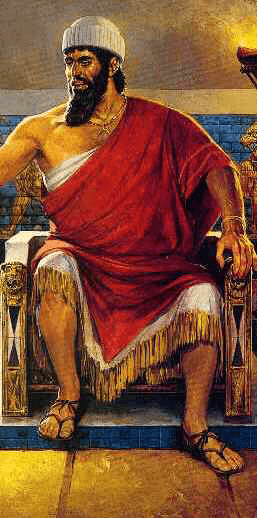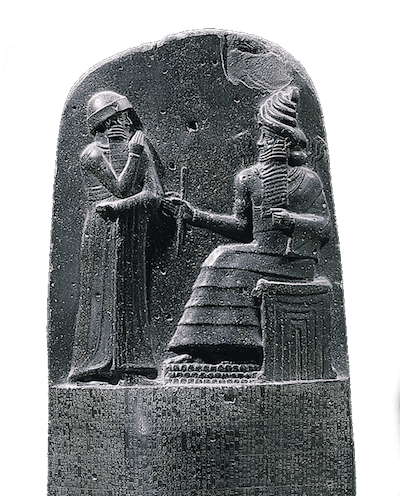People > Hammurabi
Hammurabi
Background

Hammurabi Drawing
Hammurabi was an Amorite king of the First Dynasty of Babylon that ruled over the fledgling civilization of Babylonia between 1792 BC and 1750 BC. He succeeded his father named Sin-Muballit and was responsible for greatly reforming Babylonia and being one of the most famous figures in the ancient world. As he took over following his fathers old age he greatly expanded Babylonia and is credited with creating the Old Babylonian Empire.
Hammurabi is also known for establishing one of the first codified laws known as the Code of Hammurabi which still exists today on the same stele posted in the square of ancient Babylon.
Babylon was overshadowed by older, larger and more powerful kingdoms such as Elam, Assyria, Isin, Eshnunna and Larsa for a century or so after its founding. However his father Sin-Muballit had begun to consolidate rule of a small area of south central Mesopotamia under Babylonian hegemony and, by the time of his reign, had conquered the minor city-states of Borsippa, Kish, and Sippar.[6]Early Years
When Hammurabi ascended to the throne in Babylon the small kingdom of Babylonia was undergoing political and social strife in a complex geopolitical situation with its surrounding neighbors. During this time the region of Mesopotamia contained many different city-states that all competed for the scarce natural resources of the arid region.
To the north along the northern Tigris River lay the kingdom of Eshnunna while the southern state of Larsa controlled the delta region. To the east of Babylonia lay the kingdom of Elam which was a constant regional threat to rule in Babylon. To the north lay the kingdom of Assyria under the leadership of Shamshi-Adad I and his successors.
Despite being surrounded on all sides by hostile neighbors Hammurabi was able to launch Babylona into a golden age and generate great culture and literacy through his empire. Before Hammurabi came to power the city of Babylon was of minor significance in the greater geopolitical situation in Mesopotamia during the ancient times. However, he managed to expand the territory of Babylonia far beyond the territorial borders of Babylon and is credited with founding what would become known as the First Babylonian Empire.
Hammurabi was an Amorite First Dynasty king of the city-state of Babylon, and inherited the power from his father, Sin-Muballit, in c. 1792 BC.[4] Babylon was one of the many largely Amorite ruled city-states that dotted the central and southern Mesopotamian plains and waged war on each other for control of fertile agricultural land.[5] The name Hammurabi derives from the Amorite term ʻAmmurāpi ("the kinsman is a healer"), itself from ʻAmmu ("paternal kinsman") and Rāpi ("healer").The first few decades of Hammurabi's reign were quite peaceful. Hammurabi used his power to undertake a series of public works, including heightening the city walls for defensive purposes, and expanding the temples.[9Military Campaign
] In c. 1801 BC, the powerful kingdom of Elam, which straddled important trade routes across the Zagros Mountains, invaded the Mesopotamian plain.[10] With allies among the plain states, Elam attacked and destroyed the kingdom of Eshnunna, destroying a number of cities and imposing its rule on portions of the plain for the first time.[11] In order to consolidate its position, Elam tried to start a war between Hammurabi's Babylonian kingdom and the kingdom of Larsa.[12] Hammurabi and the king of Larsa made an alliance when they discovered this duplicity and were able to crush the Elamites, although Larsa did not contribute greatly to the military effort.[12] Angered by Larsa's failure to come to his aid, Hammurabi turned on that southern power, thus gaining control of the entirety of the lower Mesopotamian plain by c. 1763 BC.[13]As Hammurabi was assisted during the war in the south by his allies from the north such as Yamhad and Mari, the absence of soldiers in the north led to unrest.[13] Continuing his expansion, Hammurabi turned his attention northward, quelling the unrest and soon after crushing Eshnunna.[14] Next the Babylonian armies conquered the remaining northern states, including Babylon's former ally Mari, although it is possible that the 'conquest' of Mari was a surrender without any actual conflict.[15][16][17]Hammurabi entered into a protracted war with Ishme-Dagan I of Assyria for control of Mesopotamia, with both kings making alliances with minor states in order to gain the upper hand. Eventually Hammurabi prevailed, ousting Ishme-Dagan I just before his own death. Mut-Ashkur the new king of Assyria was forced to pay tribute to Hammurabi, however Babylon did not rule Assyria directly.In just a few years, Hammurabi had succeeded in uniting all of Mesopotamia under his rule.[17] The Assyrian kingdom survived but was forced to pay tribute during his reign, and of the major city-states in the region, only Aleppo and Qatna to the west in the Levant maintained their independence.[17] However, one stele of Hammurabi has been found as far north as Diyarbekir, where he claims the title "King of the Amorites".[18]Vast numbers of contract tablets, dated to the reigns of Hammurabi and his successors, have been discovered, as well as 55 of his own letters.[19] These letters give a glimpse into the daily trials of ruling an empire, from dealing with floods and mandating changes to a flawed calendar, to taking care of Babylon's massive herds of livestock.[20] Hammurabi died and passed the reins of the empire on to his son Samsu-iluna in c. 1750 BC, under whose rule the Babylonian empire began to quickly unravel.[21]Code of Hammurabi
The Code of Hammurabi was a code of laws and ancient legal system that was used in ancient Babylon to maintain social order. It was one of the first inscribed of its kind and the laws were written in Akkadian on a stone stele erected in a public place for all to see. The current artifact we have today was actually looted by the Elamites and placed in their capital at Susa where it was uncovered during an archaeological dig in 1901. It is now located in the Louvre Museum in the city of Paris.

Hammurabi Engraving on the Code of Hammurabi Tablet
The recovered stele contained a code of 282 laws which was written by ancient Babylonian scribes on twelve tablets. The laws were inscribed in Akkadian so that most of the average citizens could be able to read it as not the language of cuneiform was increasingly being regulated to scribes, intellectuals and the palace/religious complex.
The structure of the code is very specific, with each offense receiving a specified punishment. The punishments tended to be very harsh by modern standards, with many offenses resulting in death, disfigurement, or the use of the "Eye for eye, tooth for tooth" (Lex Talionis "Law of Retaliation") philosophy.[23] The code is also one of the earliest examples of the idea of presumption of innocence, and it also suggests that the accused and accuser have the opportunity to provide evidence.[24] However, there is no provision for extenuating circumstances to alter the prescribed punishment.A carving at the top of the stele portrays Hammurabi receiving the laws from the god Shamash or possibly Marduk,[25] and the preface states that Hammurabi was chosen by the gods of his people to bring the laws to them. Parallels between this narrative and the giving of laws by God in Jewish tradition to Moses and similarities between the two legal codes suggest a common ancestor in the Semitic background of the two. Fragments of previous law codes have been found.[26][27][28][29] David P. Wright argues that the Jewish law used Hammurabi's collection as a model, imitating both its structure and content.[30]Similar codes of law were created in several nearby civilizations, including the earlier Mesopotamian examples of Ur-Nammu's code, Laws of Eshnunna, and Code of Lipit-Ishtar, and the later Hittite code of laws.[31]Legacy
During the reign of Hammurabi the city of Babylon rose to extremly high prominence even surpassing that of Nippur for the final time in ancient history. However, following the death of Hammurabi and the transfer of power to his successor named Samsu-iluna the Babylonian Empire began to fragment and collapse. Around 1740 BC a native Akkadian speaker named Puzur-Sin drove the Amorites and the Babylonians from Assyria and native Akkadian speakers overthrew them in the southern area around the delta.
The successors of Hammurabi were unable to retain the territory and kingdoms he had conquered and slowly each one managed to break away from Babylonia. The collapse of the Babylonian Empire would lead to the establishment of the Sealand Dynasty in the same geographical region as ancient Sumer. The successive kings of Assyria named Adasi I and Bel-ibni would continue to eat away at Babylonian territory in the north as well as Elam to the east. Soon another group known as the Kassites would invade from the northeast and soon the city of Babylon was left barely in control of its own city territory.
The final deathblow to Amorite rule over Babylon came in 1595 BC when the city was sacked and plundered by the Hittites. However, Hittite control over Babylonia did not last long and soon the civilization was conquered by the Kassites who originated from the Zagros Mountains and would rule over the great civilization for over four hundred years. While this may seem like Hammurabi did not have too much impact on the development of Babylonia since his dynasty was snuffed out pretty quickly it is important to note that the Kassites adopted Hammurabis Code of Laws.
US Government Buildings
Hammurabi is currently depicted on several government buildings in the United States of America. He is one of twenty-three historical important lawgivers that were depicted on classical bas-reliefs in the chamber of the House of Representatives in the Capital Building in Washington D.C. Another frieze constructed by Adolph Wienman depicted the great lawgivers of history included Hammurabi is located on the southern wall of the Supreme Court Building in Washington D.C. as well.
The Bible
Some theologians hold the hypothesis that Hammurabi was the biblical Armaphel of was the King of Shinar in the Book of Genesis 14:1.